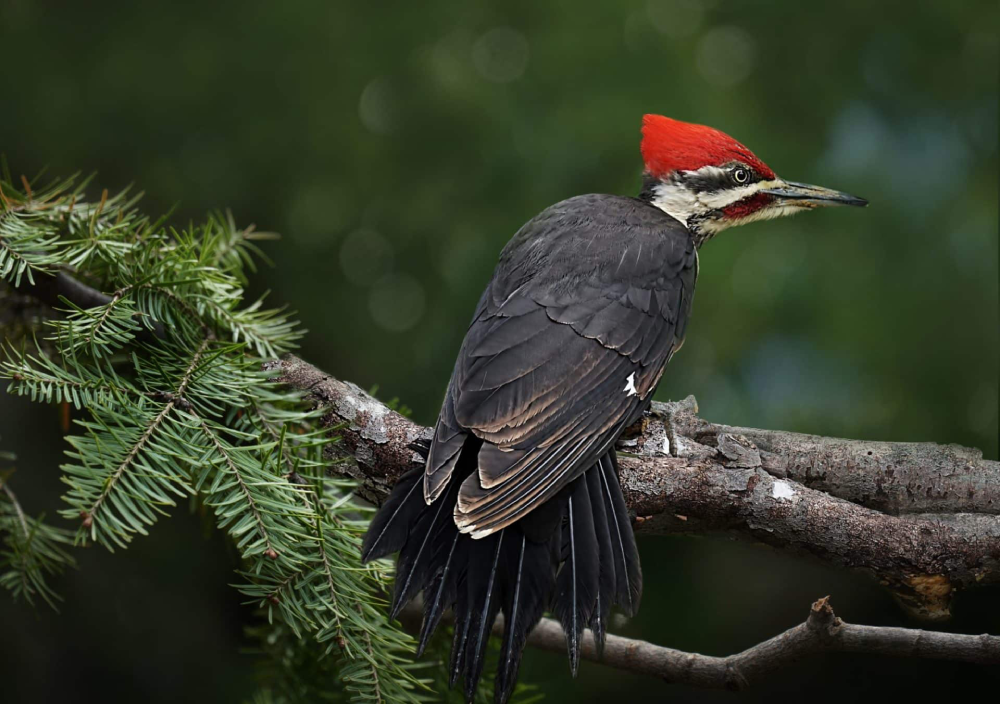Physical Characteristics
The Pileated Woodpecker is a striking bird, notable for its large size and vibrant plumage. Adults typically measure between 16 to 19 inches in length with a wingspan that can stretch up to 30 inches. Males and females are similar in appearance, both sporting a predominantly black body with white stripes running down the neck and a flaming red crest that is more pronounced in males. The bird’s bill is chisel-like, designed for powerful pecking, and it uses this formidable tool to excavate deep into trees in search of food.
Behavior and Communication
Pileated Woodpeckers are known for their distinctive drumming sounds, which serve multiple purposes, including communication, territorial signaling, and attracting mates. These birds are monogamous, often forming long-term pair bonds. Their courtship rituals include drumming, calling, and engaging in synchronized flights around their territory. The “wick-a-wick-a-wick” call of the Pileated Woodpecker is loud and carries over long distances, adding to the bird’s unmistakable presence in the forest.
Habitat and Distribution
The Pileated Woodpecker is primarily found in deciduous and mixed forests across North America, from Canada to the eastern and southeastern United States. It prefers mature forests with large, standing dead trees or snags, which provide essential nesting and feeding sites. However, these adaptable birds can also be found in suburban areas with sufficient tree cover and old forests.

Diet and Feeding Habits
The diet of the Pileated Woodpecker mainly consists of insects, particularly carpenter ants and wood-boring beetle larvae. These birds are adept foragers, using their powerful bills to chisel away at the bark and wood of trees to access insect galleries. Their feeding activities leave characteristic rectangular holes in trees, which can be quite large and deep. In addition to insects, Pileated Woodpeckers also consume fruits, nuts, and berries, particularly during the winter months when insects are less abundant.
Role in the Ecosystem
Pileated Woodpeckers play a crucial role in their ecosystems, particularly in forest dynamics. By excavating trees in search of food, they create cavities that subsequently provide nesting sites for a variety of other species, including smaller birds, mammals, and even insects. These cavities can become vital habitats for species such as owls, bats, and some ducks. Furthermore, the woodpecker’s feeding activity helps control insect populations, contributing to the overall health of the forest.
Nesting and Reproduction
During the breeding season, which typically runs from late winter to early summer, Pileated Woodpeckers engage in nest excavation. Both male and female participate in creating a nest cavity, often located high in a dead tree or a large branch. The entrance hole is usually about 3 inches in diameter, leading to a chamber that can be up to 2 feet deep. The female lays 3 to 5 white eggs, which both parents incubate for about 15 to 18 days. Once the chicks hatch, both parents share the responsibilities of feeding and caring for the young until they fledge approximately a month later.
Conservation Status and Threats
The Pileated Woodpecker is currently classified as a species of least concern by the International Union for Conservation of Nature (IUCN). However, it faces several threats, primarily habitat loss due to logging, urbanization, and deforestation. Conservation efforts focus on preserving mature and old-growth forests, ensuring the availability of suitable nesting and foraging habitats. The Pileated Woodpecker’s ability to adapt to fragmented forests and even suburban environments has helped maintain stable populations in some areas.
Conclusion
The Pileated Woodpecker is a fascinating and vital component of North American forests. Its striking appearance, distinctive behaviors, and ecological importance make it a subject of interest for bird enthusiasts and conservationists alike. So, as we continue to understand and appreciate this remarkable bird, efforts to conserve its habitat will ensure that the Pileated Woodpecker remains a vibrant and integral part of our natural heritage.









